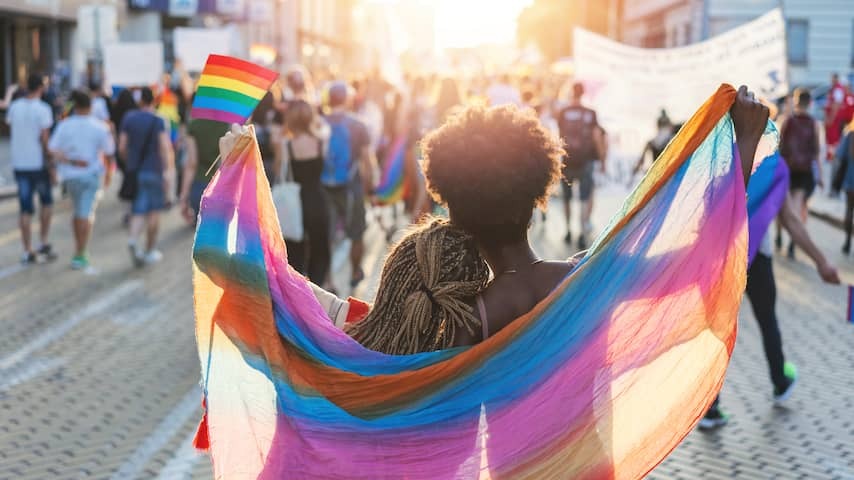
This month, you’re likely to see more rainbows than in the rest of the year. During the annual Pride celebrations, flags are flying, and you might even find yourself in a rainbow outfit at a Pride party. But do you help LGBTQIA+ people by partying along?
If you wear a little rainbow on your jacket – and don’t take it off immediately after your Pride party – you’re showing a large group of people that they can be themselves around you. And if, for example, a trans person gets into a taxi with a little rainbow hanging from the rearview mirror, it makes quite a difference.
Someone doesn’t have to be wary of transphobia, says Anna Berbers. She is a university lecturer in Communication Science at the University of Amsterdam and obtained her doctorate on the theme of pinkwashing.
People who work in healthcare or education show their clients and students that they can feel safe with them with such a rainbow. With such a symbol, you are an ally. And that is worth a lot, say experts Berbers and Charlot Pierik, project leader of inclusion and diversity at knowledge institute Movisie.
“Such a visual sign is a nice first step,” says Berbers. “Sincere support then requires further steps. Find out what it really means to live as part of the LGBTQIA+ community in the Netherlands. Of course, celebrate Pride cheerfully, but also speak out if you encounter homophobia, transphobia and discrimination.”
How are we doing?
The Netherlands dropped this year on the Rainbow Europe Index, the European ranking of LGBTQIA+ rights. We are in thirteenth place, while a few years ago that was still the fifth place.
There are large differences in the attitude towards the individual LGBTQIA+ groups. This is evident from the annual LGBTQIA+ monitor, which Movisie carries out and bases on population surveys by the Social Cultural Planning Office.
The least positive are bi+ people and non-binary people. For example, 30 percent of respondents see it as a fashion phenomenon. More than 20 percent of male respondents feel uncomfortable with open expressions of homosexuality.
More rainbows on more jackets
Berbers: “We like to see ourselves as broad-minded. But are you really? Do you speak out if a colleague stubbornly keeps saying ‘he’ and ‘him’ to a non-binary colleague? Can you accept that some gay men like to wear a drag outfit? Do you use your friendly, lesbian neighbor to excuse your own transphobia?”
We think we are a tolerant country, says Berbers. But meanwhile, research shows that many people would rather not have a trans person as a neighbor, or do not want their child’s teacher to be non-binary. “We need more activism.”
And we need more rainbows on our jackets, says Pierik. Among other things, she deals with rainbow municipalities. These are municipalities in the Netherlands that actively work on the social acceptance, safety and emancipation of LGBTQIA+ people. There you see rainbow crosswalks, benches or flags. These are regularly destroyed, says Pierik.
“Not only should you stay away from other people’s stuff, but it also shows that there are still people who feel threatened when homosexuality becomes visible. And those people break something.”
Or it takes a mild form: sighing that you are getting tired of all those rainbows and that it is enough for once. Pierik: “We need to have a conversation about that. What exactly are you getting so tired of? What exactly is being pushed down your throat? The big misconception that is still being made is that something is being taken away from you if there is more space for others. That is not the case. That’s what I get tired of.”
Pride is a party and a protest
Are you getting tired of public expressions of homosexuality or gender diversity, or do you not want to hear it anymore? Feel free to get used to it at your own pace, but it will not disappear, says Pierik.
“I don’t want to live in a world where others determine how visible I am. Then there is no end in sight. In the long term, that is not legally sustainable. This group exists, we have always been there and we will not disappear. Don’t forget that this visibility that you see today has only existed for about twenty years. So you can’t be that tired.”
Getting tired of Pride, but not of the Caribbean carnival, Revival or one of the many other parties of subcultures in the Netherlands is no coincidence, says Pierik. According to her, we are more critical when it comes to LGBTQIA+.
Pride is a party, say both inclusion experts, but one that comes with historical awareness. “In addition to a party, it is also a protest against homophobia and transphobia, discrimination and inequality,” says Berbers. “If we only see Pride as a fun party, a kind of pink King’s Day, then we run the risk of thinking that everything is fine here. Then we forget that there is still work to be done.”